The iPad Air Review
by Anand Lal Shimpi on October 29, 2013 9:00 PM ESTiPhone to iPad: CPU Changes
Although the iPad Air uses the same A7 from the iPhone 5s (and M7 motion coprocessor), there are a few minor differences that do lead to better performance.
At a high level we’re still talking about two 64-bit Apple Cyclone cores with 128KB L1s (64KB I$ + 64KB D$) per core, a shared 1MB L2 cache and a 4MB L3 cache that services the entire SoC. Apple increased CPU frequency from 1.3GHz to 1.4GHz in the iPad Air, a mild increase but in line with what we’ve seen from previous iPad designs. That’s the first impact on performance - a 7.69% increase in CPU frequency.
The second impact on performance is something I only noticed while digging around under the hood of the A7. It seems like the implementation in the iPad Air can, for whatever reason, hold more instructions in flight (over 20% more) than the A7 in the iPhone 5s. It’s unclear to me whether the A7 in the iPad is configured any differently via firmware/microcode or if perhaps we’re looking at a slightly different revision of the core, but the delta was repeatable in my testing.
The third, and likely biggest change impacting the iPad Air’s implementation of the A7 is the additional thermal headroom afforded by the larger chassis. I’m not going to go into details on exactly what this next test does (unfortunately we’re going to occlude some of the low level work that we do in light of all of the benchmark cheating going on), but we’re looking at a curve of performance vs. time for a particularly power heavy mix of code. We’re running the same exact code on both the iPad Air and iPhone 5s here, the only real difference is the size of the chassis:
You can see the 5s throttles back its CPU frequency to about 1GHz after the 2 minute mark. The crazy thing is that until that point the 5s manages to run at full frequency without so much as a hiccup for two full minutes, running an incredibly power hungry task. Given that most iOS apps aren’t this power intensive for such a sustained period of time, iPhone 5s users should almost always see the A7 running at a full 1.3GHz. Pretty crazy.
The iPad Air by comparison shows much more controlled behavior. Early on in the test we see a 7.7% performance advantage, which lines up perfectly with the iPad Air’s 7.7% CPU frequency advantage. By the end of the test the iPhone 5s has throttled to 900MHz, while the iPad Air drops to around 1.2GHz. At this point the iPad Air’s performance advantage grows to almost 40%.
CPU Performance
I've gone through our standard set of cross-platform browser based benchmarks to place the iPad Air's performance in perspective. As I mentioned in our 5s review, I don't know that there are many (any?) applications on iOS 7 that can really take advantage of all the A7 has to offer. There's definitely a ton of headroom left in the design. What's particularly exciting is when the A7 ends up in n-1 or n-2 iOS devices and it becomes the minimum developer target going forward.
I won't go through all of the results here again, but it's safe to say that the iPad Air is the fastest ARM based tablet on the planet at this point.
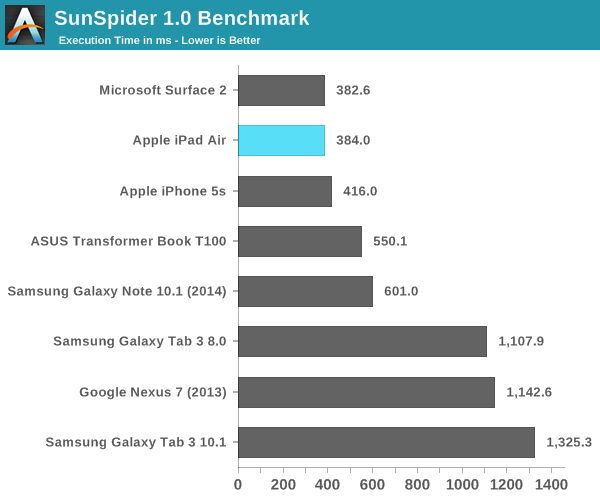
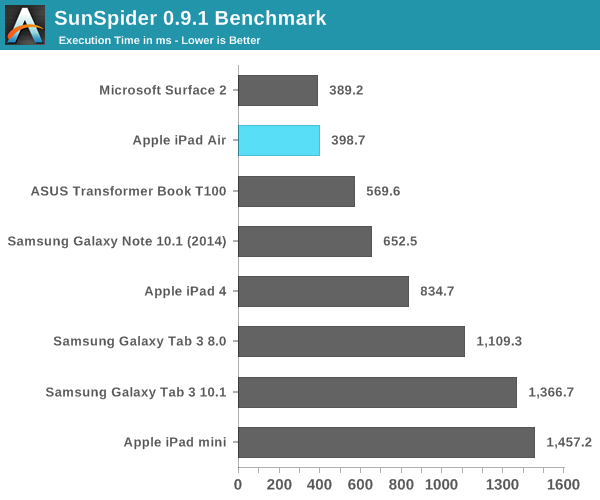
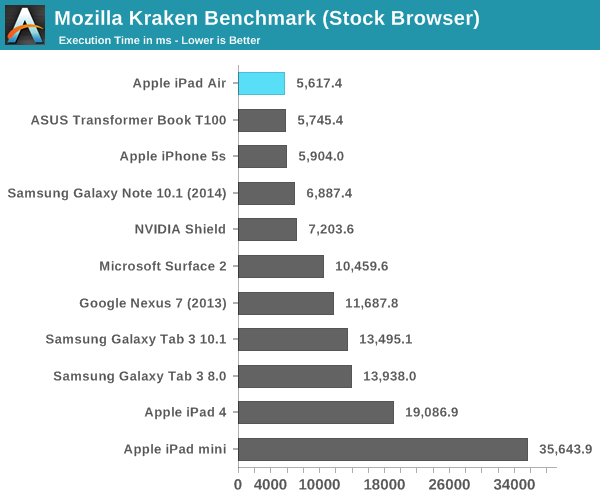
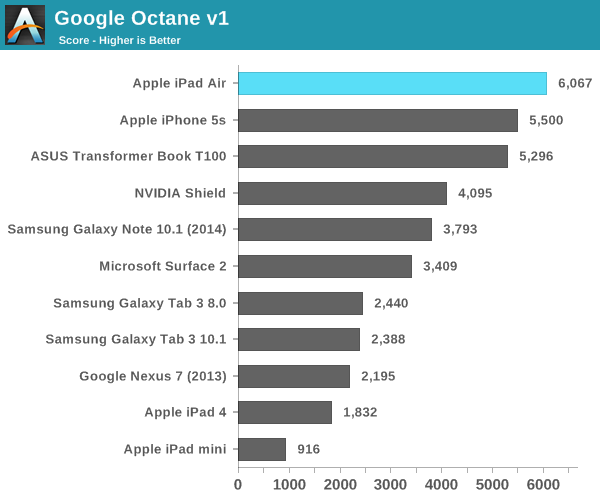
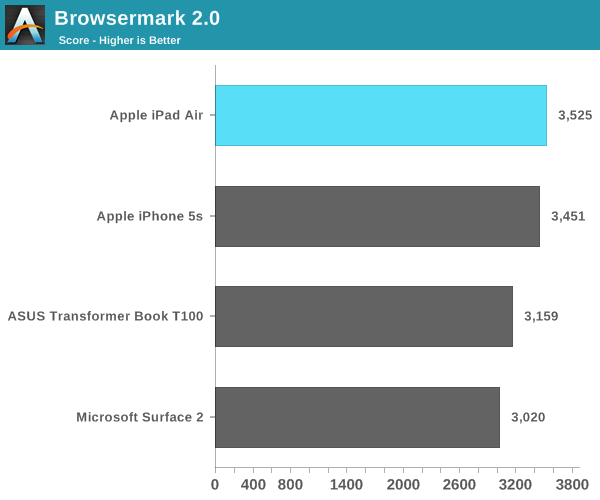

A7 Power Consumption
I’ll get to battery life in a bit, but I’ve been curious about the dynamic range of power consumption offered by Apple’s new A7 SoC. On the one hand we’re dealing with a lower power process (28nm vs. 32nm), but on the other hand Apple’s Cyclone cores can clearly draw more power given how beefy the architecture is this round. Apple frowns upon review sample dissection so I had to turn to a less scientific method of external platform level power measurement. The fidelity of the numbers here aren’t all that great but it’s better than nothing.
For the first test I measured platform power consumption during a Kraken run:
I purposely started measuring before the benchmark so I could get an idea of idle power consumption. The iPad Air consumes roughly 72% of the idle power as the iPad 4, both running at the same brightness. Here we’re not just seeing the A7’s advantages but also things like lower display power.
Focusing on the load portion of the measurement we see that both the new iPad and old iPad consume the same total power in this test. I suspect the A7 is drawing more power than the A6X, but it’s masked by a lower power display. Given how much faster the iPad Air is, Apple’s latest tablet features far lower overall task energy than the outgoing iPad 4. This is probably both the best case scenario for the iPad Air and the most likely case as well.
For kicks I wanted to see just how much power I could get the iPad Air to draw. Here I’m looking at platform power during our mini-power-virus test from above:
How’s that for dynamic range? Almost 12W running all out, but around half that in what we’d normally consider to be a stressful CPU test. I couldn’t get any actual applications/games on the iPad Air to behave like this so the results above are purely academic (for now). A quick run through GFXBench 2.7’s T-Rex HD test confirms that even pushing the GPU won’t hit these numbers. The max I saw running T-Rex offscreen was ~6W, and turning to an actual game (Infinity Blade 3) the iPad Air pulls less than 5W.


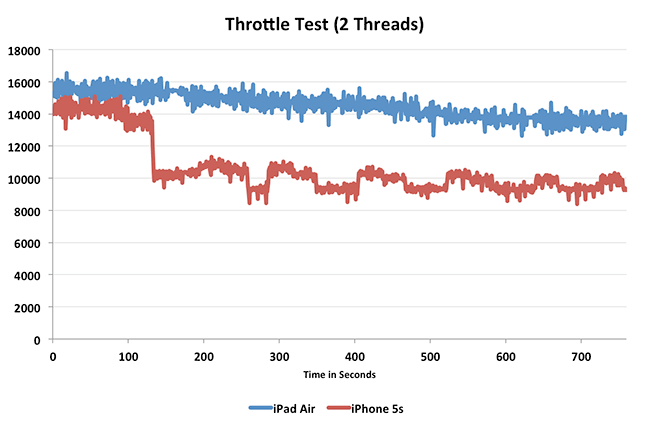
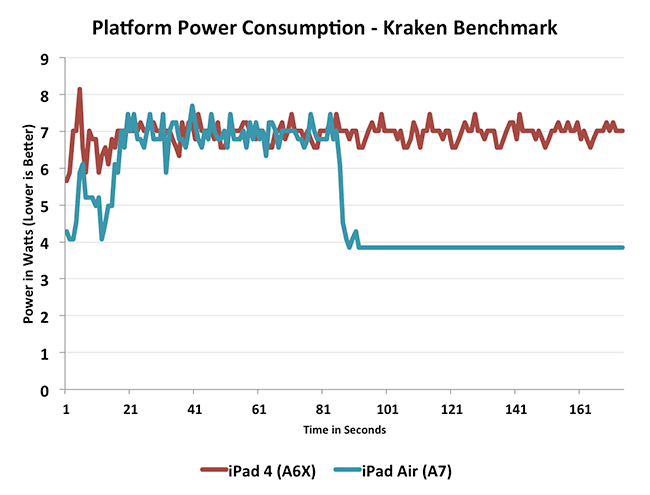
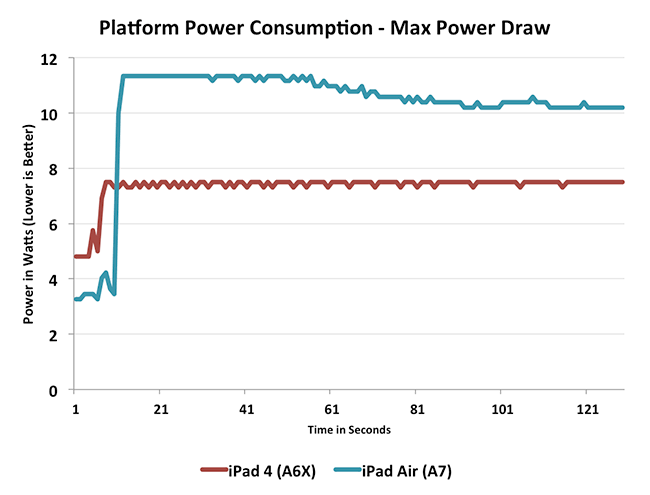








444 Comments
View All Comments
rituraj - Wednesday, October 30, 2013 - link
What?dugbug - Wednesday, October 30, 2013 - link
astroturfKevin G - Wednesday, October 30, 2013 - link
Whoa, 6 issue architecture in a phone/tablet? Apple wasn't kidding when they said 'desktop class' performance. I'm wondering what low level power management voodoo they have going to pull that off.The flip side is that if Apple wanted to build a real desktop/server class chip, they look like they could pull it off and be competitive with Intel. Disable Turbo and throttle down a Haswell to 1.4 Ghz and do a performance and performance per watt comparison. I fathom that Intel still leads but Apple's A7 design will be seriously competitive.
I am in agreement that Apple should have moved to 2 GB of memory here. One could argue the merits of keeping with 2 GB on the phone but in the age of retina displays on tablets, it'll seem constrained over the long term. This would have been an ideal way to distinguish the iPad's hardware from the iPhone in terms of hardware features/performance. Ditto for not going with a 128 bit wide memory interface. Hell, it would have made sense for Apple to build the die with a 128 bit wide bus but only use the full width in the iPad.
ananduser - Wednesday, October 30, 2013 - link
Intel's Atom runs a full size desktop OS. That's more of a load on it than simple mobile software like ios. The best ARM can muster is not even close to Intel.Arbee - Wednesday, October 30, 2013 - link
iOS is OS X (true BSD UNIX) with a different top level GUI. Similarly, Android is creeping towards feature parity with desktop Linux, although they have farther to go on audio and MIDI, and Windows Phone runs the real NT kernel. They're all a lot less different from a "full size desktop OS" than you seem to think.Kevin G - Wednesday, October 30, 2013 - link
There is an Android port for x86 which would put Atom SoC's like Baytrail on equal footing.The thing is that the Cyclone core is wider than even Haswell: 6 vs. 4. (For reference Silvermont is 2 issue.) Haswell likely has a higher throughput of instructions considering its x86 ISA (more load/stores for example) and different balance of execution units.
errorr - Wednesday, October 30, 2013 - link
It is reportedly a very buggy port and DALVIK is broken which means it is useless. Plus it is not 64bit enabled yet which hurts bay trail.Wilco1 - Thursday, October 31, 2013 - link
Cyclone may well be 6-issue, but that's not unusual: Cortex-A15 is 8-issue. This is a design decision based on whether to use a single big issue queue or multiple separate issue queues (there are advantages/disadvantages either way). However it seems likely it is 4-way decode, just like Haswell. And the decode rate determines the sustained performance.KPOM - Wednesday, October 30, 2013 - link
Perhaps battery life came into play. Remember, Apple doesn't add specs for the sake of winning spec wars. They may also be trying to discourage developers from simply writing RAM-hungry apps that will leave the iPhone 5c and iPad 2 behind. 64-bit is supposed to be a smooth transition.Plus, I'm sure they're looking to keep some reasons to upgrade to an "iPad Air 2" or "iPad Pro" next year. 2GB would be nice, but I don't think 1GB will be a problem for most users.
YuLeven - Wednesday, October 30, 2013 - link
As we're kindly reminded in every other tablet's review about things like 'this tablet is good, but it don't have the number of tablet optimized that the iPad has', I would kindly like to remind you a couple of small... well, shortcomings of the iPad. Ups, I said that.The iPad is good, but it can't open two apps at once.
The iPad screen is great and sharp, but it's 4:3 aspect ratio is far worse than 16:9 for video watching, specially TV (Netflix, Hulu) shows.
The iPad is bright, but its far more reflexive than Surface's.
The iPad is good, but you don't have USB mass storage mode.
The iPad is good, but you can't expand your memory.
The iPad is good, but you can't use your external HD, pendrive, printer, mouse and other hardware stuff via USB port.
The iPad is good, but office experience on it falls short of the one on Windows RT.
The iPad is good, but you can't have a browser running on the background, for exemple for listening to some youtube music video while you have two other apps running on the front end.
The iPad gestures are good, but multitasking by a simple swype from the left feels better than having to using four finger at once.
The iPad is light and it's ok to use the cover as a stand, but it feels less confortable than having a real, sturdy quickstand.
The iPad thousands of apps are great, but some of them are worse than using the actual website: Facebook and Pandora, for example.
The iPad is good, but its experience using a remote desktop is worse than on other tablets.
Well, the list goes on.
Not that the iPad is a bad tablet, quite the opposite actually. But as reviews usually like to remind us of things that Android/Windows RT tablets can't do - and the iPad always can, as a matter of fact -, I wanted to recall some things that Android/Windows RT do superbly - and the iPad don't, as a matter of fact -.